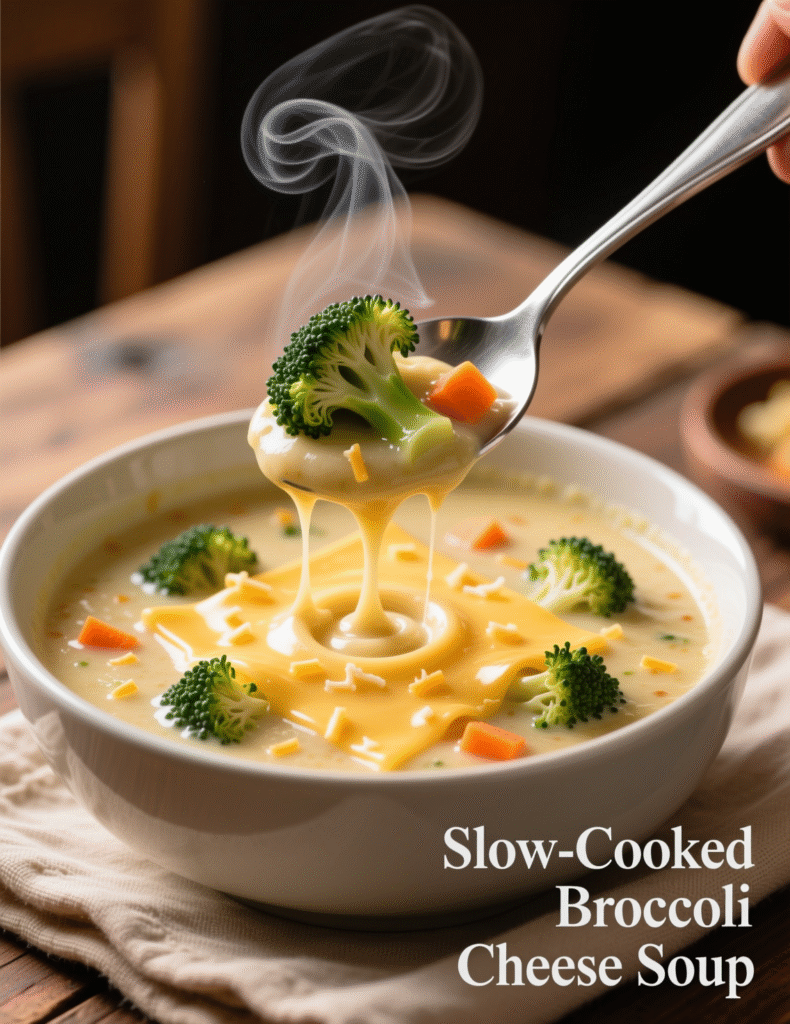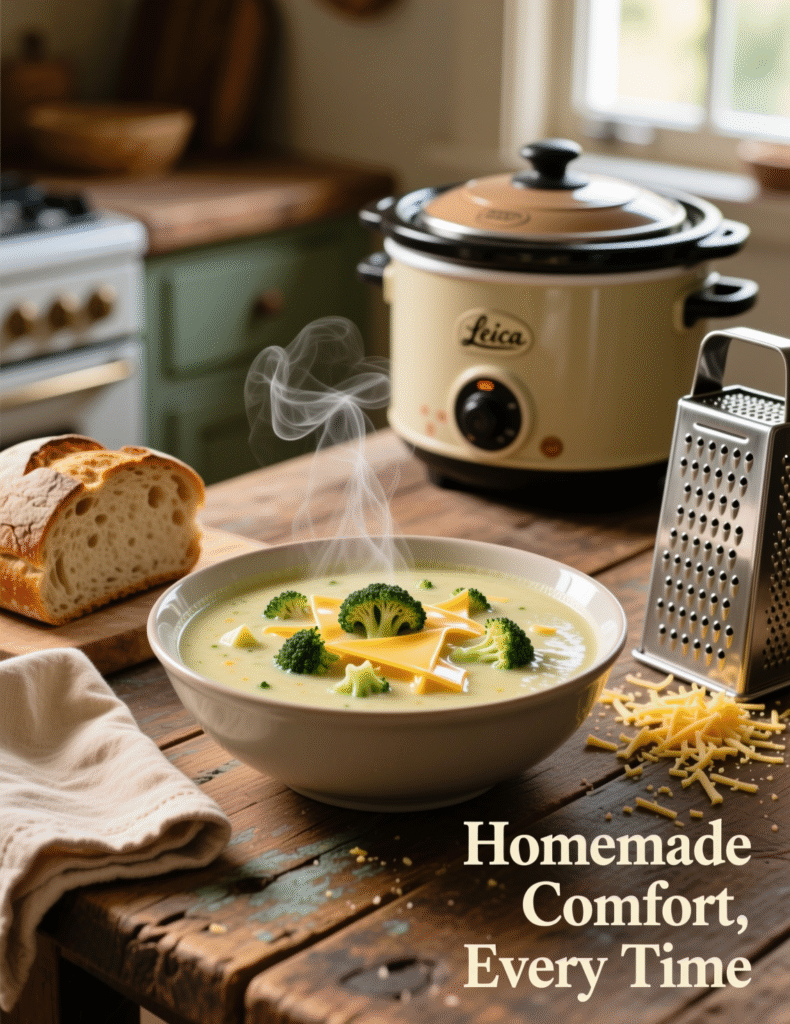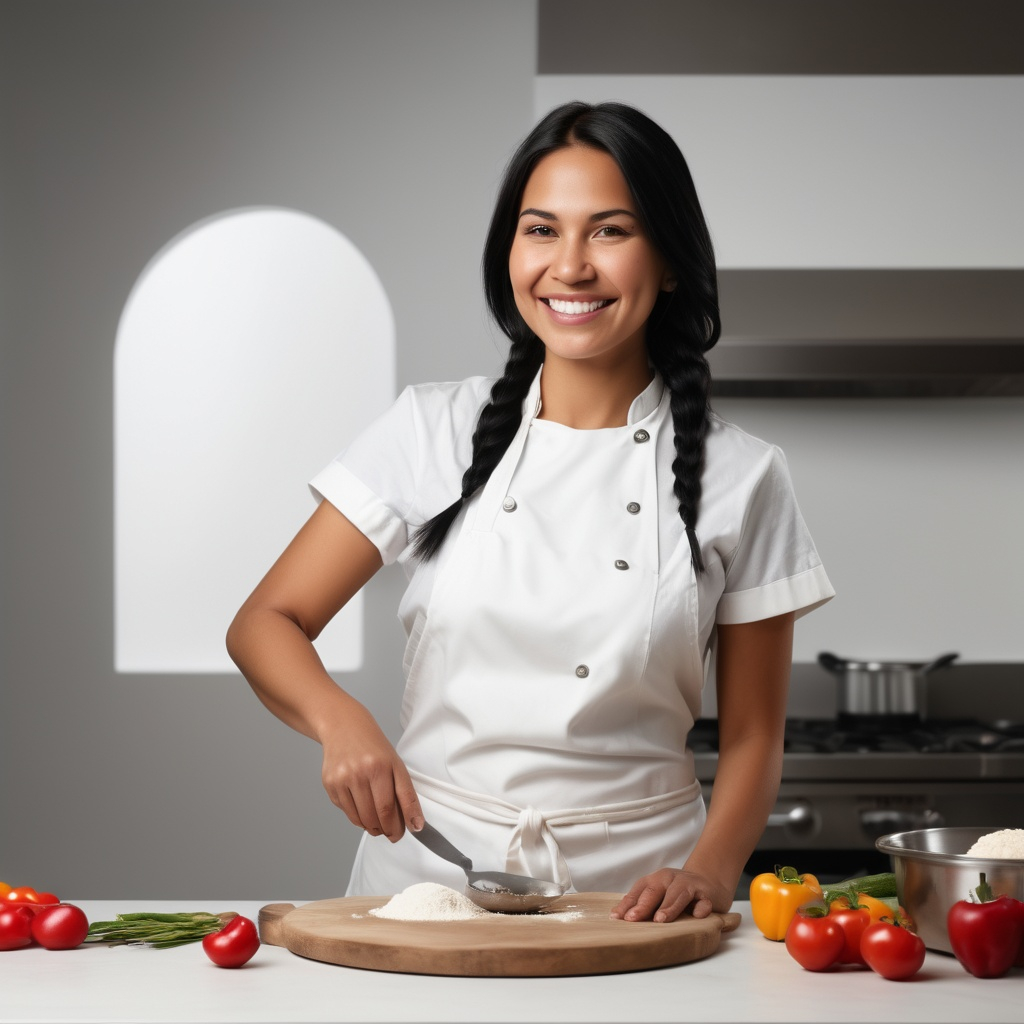When the weather turns cold and you crave something warm, creamy, and downright cozy, nothing beats a bowl of broccoli cheese soup. But here’s the thing—most people make it wrong. They either overcook the broccoli until it’s mushy or drown the soup in heavy cream until it loses that clean, earthy broccoli note. Let’s fix that. This slow cooker version brings out the best of both worlds: creamy comfort with a fresh, balanced flavor that holds its ground.
I’ve cooked this recipe hundreds of times for testing menus and client tastings, and let me tell you—it’s foolproof. It’s the kind of dish that makes your kitchen smell like a professional bistro without demanding that you stand over a pot all day. Slow cookers are your silent sous chefs, and when handled properly, they turn simple ingredients into restaurant-level magic.
Why Slow Cooker Broccoli Cheese Soup Works So Well
Most chefs underestimate the slow cooker. They think it’s for busy home cooks who don’t want to babysit a pot. But in reality, a slow cooker is one of the best tools for developing deep, complex flavors without scorching dairy or overcooking vegetables.
Broccoli, when cooked too fast at high heat, releases sulfur compounds that make it smell and taste off. Slow, gentle heat reduces that harshness. It coaxes out sweetness, earthy notes, and a nutty depth that pairs beautifully with cheese.
The cheese, too, benefits from the gradual cooking process. Instead of clumping or curdling, it melts evenly into the soup base, giving it that silky, almost luxurious texture. The kind of texture that coats your spoon just enough, leaving trails of golden cream behind.
The Ingredients (and Why They Matter)
A professional recipe isn’t just about listing ingredients—it’s about understanding their behavior. Here’s the lineup and why each plays a vital role.
Broccoli (4 cups, chopped): Always go for fresh broccoli if possible. Frozen can work, but it tends to release more water and can make your soup thinner. Trim the stems, don’t toss them; they’re packed with flavor and fiber.
Cheddar Cheese (2 cups, shredded): Sharp cheddar gives the best punch. Don’t use pre-shredded cheese—it contains anti-caking agents that can make your soup grainy. Shred it fresh; the melt will be clean and smooth.
Carrots (1 cup, grated): They add sweetness and color balance. You don’t really taste “carrot,” but it rounds out the richness of the cheese.
Onion (1 medium, chopped): A good soup always starts with aromatics. Sautéing the onion first in a bit of butter before adding it to the slow cooker creates a deeper base flavor.
Garlic (3 cloves, minced): Don’t skip it. Garlic adds warmth and aromatic complexity that brings out the savory side of cheddar.
Chicken Broth (4 cups): Go with low-sodium broth. You’ll control the seasoning better when adding cheese later.
Heavy Cream (1 cup): For body and silkiness. Half-and-half can work, but the texture won’t be as rich.
Butter (3 tablespoons): Adds flavor and richness that carries the dairy through the broth.
Flour (3 tablespoons): This is your thickener. It helps bind the fats and liquids so your soup doesn’t separate.
Salt, pepper, nutmeg: Nutmeg’s optional, but I always use a pinch—it brightens the cheese flavor like a whisper of magic dust.

How to Make It Perfectly (Expert Steps)
You’ll start by melting the butter in a small pan and whisking in the flour. Let it cook for about a minute. That’s your roux—the foundation of creamy soups. If you skip this or rush it, your soup will taste floury or separate later on.
Transfer that roux to your slow cooker. Add the broth, whisking gently to dissolve any lumps. Drop in your onions, garlic, carrots, and chopped broccoli. Stir well.
Set your slow cooker on low for 4 hours or high for about 2 hours. Don’t overcook it. The broccoli should be tender but still bright green.
Now comes the important part. Turn the cooker to “keep warm” or low, and stir in the heavy cream and cheese a handful at a time. Don’t just dump it in. The gradual melting ensures even texture and prevents curdling.
If the soup feels too thick, add a bit more broth or cream. If it’s too thin, you can mash some broccoli with the back of a spoon or use an immersion blender for a velvety consistency.
Pro Tips Only Chefs Use
- Temperature control is everything.
Cheese melts best between 150–180°F. Anything hotter, and it breaks. That’s why slow cookers shine—they hover right in that safe zone. - Texture contrast makes the experience.
Leave a few broccoli chunks intact. Pureeing everything gives you baby food vibes. Texture brings life to a bowl. - Fresh cheese is non-negotiable.
I can’t say it enough—pre-shredded cheese ruins good soup. Always shred right before adding. - The secret seasoning trick:
A pinch of mustard powder or Worcestershire sauce enhances cheddar’s sharpness without being obvious. It’s a quiet, behind-the-scenes flavor enhancer. - Add acidity at the end.
Just a teaspoon of lemon juice right before serving wakes up the flavors. It cuts through richness beautifully.
Common Mistakes (and How to Avoid Them)
Mistake #1: Boiling after adding cheese.
This is the number one reason soups break. Once you’ve added cheese, no more boiling—ever.
Mistake #2: Over-salting early.
Cheese contains salt. Always season after the cheese has melted and tasted it.
Mistake #3: Using watery broth.
If your broth is weak, your flavor will be too. Always use a good-quality, full-flavored stock.
Mistake #4: Adding cream too early.
Cream should go in near the end to prevent curdling. Heat and dairy have a delicate relationship.
The Science Behind the Creaminess
Professional chefs love talking about emulsification—it’s the backbone of creamy soups. When fat and liquid combine properly (with the help of starch from flour), they create a smooth suspension.
The slow cooker’s gentle heat gives the starch time to hydrate and expand, while the cheese proteins melt evenly. That’s why this recipe yields a luxurious, thick texture without tasting greasy or heavy.
A quick chemistry fact: cheddar cheese contains casein proteins that bond with fat molecules as they melt. If overheated, they break apart, causing separation. Keeping your temperature stable ensures those proteins stay intact, creating a consistent, velvety soup.

Nutritional Insight (Because Knowledge Matters)
For professionals concerned about dietary balance, here’s the breakdown for a standard 1-cup serving (approx.):
- Calories: ~300
- Protein: 14g
- Fat: 22g
- Carbs: 11g
- Fiber: 2g
You can make it lighter by replacing half the cream with milk or even unsweetened almond milk, but the flavor depth will slightly change. If protein’s your focus, toss in a scoop of unflavored whey isolate at the end—yes, it works beautifully without affecting taste when whisked properly.
Serving Ideas That Elevate the Dish
Don’t just pour and serve. Presentation matters, even for soup.
Try serving it in small bread bowls—sourdough or country-style. The crust adds chew, and the broth seeps in just enough to make it a dream.
Top with a handful of extra shredded cheddar, a sprinkle of paprika, and maybe a drizzle of cream for drama. If you’re plating for guests, add a few small roasted broccoli florets on top—they signal freshness and texture.
For pairings, crusty bread, soft pretzels, or even garlic butter biscuits complement the richness. A chilled glass of chardonnay or sparkling apple cider cuts through the creaminess with crisp contrast.
Expert Variations
1. Smoked Broccoli Cheddar Soup:
Add smoked paprika or a bit of liquid smoke. The flavor takes on a campfire warmth—perfect for fall menus.
2. Broccoli Cheddar Bacon Twist:
Add crisp bacon bits before serving. The salt and crunch transform the texture profile entirely.
3. Vegan Option (Yes, You Can):
Use coconut milk instead of cream and vegan cheddar. Add nutritional yeast for a cheesy flavor boost. Keep it on low to prevent separation.
4. High-Protein Power Bowl:
Stir in cooked shredded chicken or diced turkey breast for extra protein. It turns into a complete meal.
Industry Insight: Why It’s So Popular
According to data from the National Restaurant Association, soups featuring broccoli and cheddar remain among the top 10 comfort dishes sold during colder months. Consumers crave that nostalgic warmth but still want something that feels “homemade.”
Slow cooker soups hit that sweet spot—they deliver homemade taste with minimal active labor. For professional kitchens, especially catering or meal prep operations, slow cooker soups offer scalability and consistency. You can multiply the recipe tenfold and get the same creamy results every time.
A Chef’s Anecdote
I remember once during a tasting event, a guest asked if I’d used ten different cheeses. I hadn’t—just sharp cheddar, fresh cream, and a slow cooker doing what it does best. That’s the beauty of technique over complexity. The best food doesn’t scream for attention—it whispers, and you just know it’s right.
Storage and Reheating Tips
If you’re meal-prepping, this soup keeps well. Refrigerate for up to 4 days or freeze for up to 3 months.
When reheating, do it slowly over low heat. If it separates slightly, whisk in a tablespoon of cream or milk—it’ll re-emulsify. Never microwave it on high; gentle heat brings it back to life beautifully.
Final Thoughts
A bowl of broccoli cheese soup may seem humble, but when made right, it’s pure artistry. It’s not just about melting cheese and tossing in broccoli—it’s about timing, temperature, and respect for ingredients.
The slow cooker lets you step away, but it doesn’t mean you lose control. Instead, it becomes your quiet partner, coaxing depth and texture you can’t rush on a stovetop.
So next time you crave something creamy, rich, and comforting, let this recipe remind you that good cooking isn’t always about fancy techniques—it’s about patience, balance, and knowing when to let the ingredients speak for themselves.
Once you master this, you’ll realize that the best recipes aren’t hard—they’re just honest. And this one, my friend, might just be the most honest broccoli cheese soup you’ll ever make.
FAQs
How long does it take to cook Slow Cooker Broccoli Cheese Soup?
It takes about 4 hours on low or 2 hours on high in the slow cooker.
Can I use frozen broccoli instead of fresh?
Yes, but it may make the soup slightly thinner, so reduce the broth a little.
Why shouldn’t I use pre-shredded cheese?
Pre-shredded cheese contains anti-caking agents that can make the soup grainy.
Can I make this soup vegetarian?
Yes, just replace chicken broth with vegetable broth.
How can I thicken the soup more?
Mash some cooked broccoli or blend a portion of the soup for a thicker texture.
Can I freeze Slow Cooker Broccoli Cheese Soup?
Yes, freeze it for up to 3 months in airtight containers.
What’s the best cheese for this soup?
Sharp cheddar cheese gives the richest flavor and best melt.
Can I add other vegetables to this recipe?
Absolutely, carrots, cauliflower, or celery blend beautifully with the base.
How do I reheat this soup without curdling?
Reheat gently on low heat, stirring often, without boiling.
Why add nutmeg or mustard powder?
They subtly enhance the cheese flavor, giving depth and warmth.
Can I make this soup lighter?
Yes, use half milk and half cream, or even almond milk for a lighter version.
How many servings does this recipe make?
It makes 6 hearty servings, perfect for a family meal.
Can I make it without flour?
Yes, blend a portion of the soup for natural thickness without flour.
How long does it last in the fridge?
It stays fresh for up to 4 days when refrigerated properly.
What’s the secret to creamy, smooth soup?
Add cheese slowly on low heat and never boil after adding it.

Marie Smith is a passionate recipe blogger, sharing easy, delicious, and creative culinary ideas that inspire home cooks to elevate everyday meals with flavor and simplicity.
